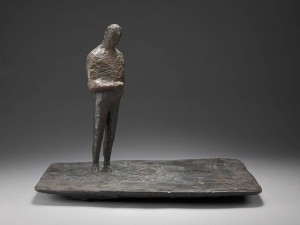Here’s a classroom activity using Reg Bulter’s Man (early 1960s) from the online collection.
Lesson: Explore the value of location, view-point, and narration.
Activity: class drawing, reading, and writing
Process: Use all three images from the online collection
Draw image (10 min) whole or detail. Respond in writing to the following questions (5 min). What is the mood? What is the story?

Draw second image (10 min) whole or detail. Respond in writing to the following questions (5 min): What is the mood from this perspective? What is the story?
Draw third image (10 min) whole or detail. Respond in writing to the following questions (5 min): What is the mood from this perspective? What is the story?
Reflection and follow up: If you had only seen one of these images what would you know in terms of mood and story?
In what ways might we use our classwork today towards understanding the effect of location, view-point, and mood when we read literature? When viewing works online? When reading a news story?
Example: Although I generated the lesson for the students and their needs, I too benefit from ‘seeing perspective’ and participating with them. Here’s a clip from my journal covering two of the steps.

Place in the Classroom
The activity generated quite a bit of conversation in the classroom the following day. Students gained perspective on a range of skills and frameworks — from seeing perspective to the role of location in story telling.
–James Shivers


Thanks for this! Such a rich lesson…covering perspective and also the repeated time spent with something rather than moving on too quickly. I like doing a similar lesson where we draw something for one minute, then write…then draw same thing for five minutes, and write…then draw it again for ten and write. Pushes the limits of what we see when we look harder.
Also a wonderful idea. As the year goes on we have been able to draw and write for longer periods of time. Their homework that night was to finish their writing or drawings. A number of students read their work the next day. I did have a couple of students wonder why we were still drawing the ‘same’ thing. Great question. So, we began talking so I could understand what they were thinking. Others ran with the prompt and invitation. The next day as students shared their work and raised questions we moved to a whole class discussion on perspective.
Thanks so much for your input and insights. I will definitely try!